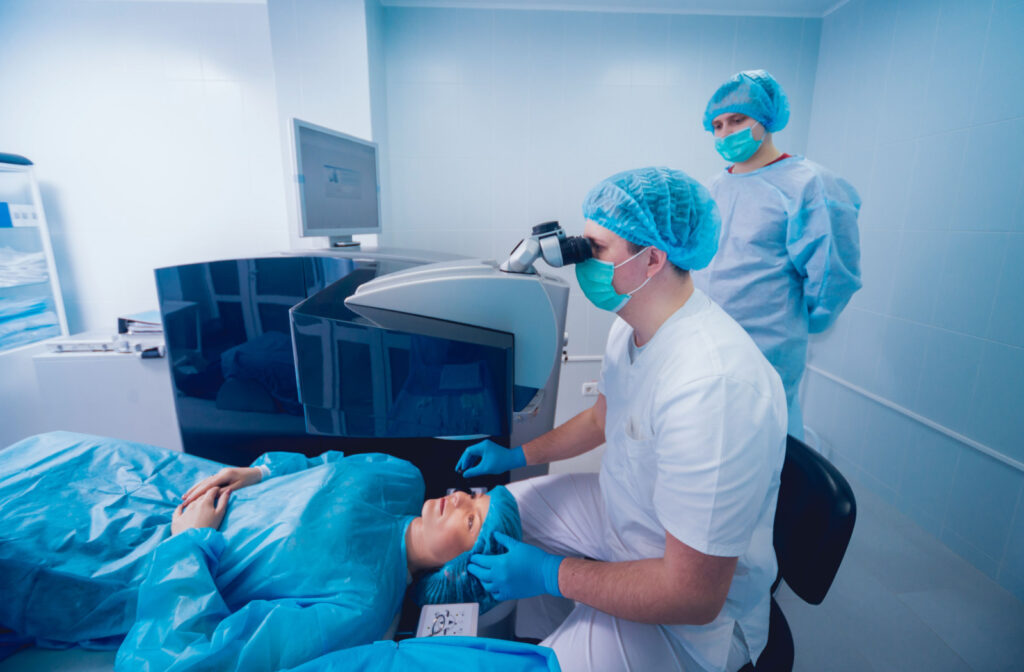When it comes to vision issues, there are many different terms and conditions that you may hear. Two common vision problems are presbyopia and myopia, but what do they mean, and how are they different? A primary difference between the two is that myopia, or nearsightedness, develops in childhood, whereas presbyopia typically emerges after age 45.
It’s possible to correct both myopia and presbyopia, and by visiting your optometrist for an eye exam, you can find the right solution and restore visual clarity.
What Is Myopia?
With myopia, or nearsightedness, you have difficulty seeing objects in the distance but will likely have no issues with close-up tasks like reading. When the eye is too elongated, or the cornea is overly curved, light enters your eyes and falls short of the retina, causing vision to blur.
Myopia emerges in childhood, typically between the ages of 6 and 12. Myopia can be caused by various factors, including genetics and environmental factors like spending long hours on digital screens or not spending enough time outdoors.
Common symptoms you can experience with myopia include:
- Holding objects like books and phone screens very close to the face
- Squinting to see clearly
- Eye strain and fatigue
What Is Presbyopia?
Most people will experience presbyopia as they get older, typically over the age of 45. It occurs when the lens in the eye becomes less flexible and cannot focus light on the retina. This makes it more challenging to focus on nearby objects. Presbyopia can lead to difficulty reading and blurry vision when working on a computer or phone.
The most common symptoms of presbyopia include:
- Needing to hold objects farther away to see them clearly
- Headaches
- Eye strain
The Difference Between Presbyopia & Farsightedness?
Hyperopia, or farsightedness, can seem similar to presbyopia, but while they both affect near vision, they’re very different. Farsightedness occurs when the eyeball is too short, or the cornea is too flat, causing the light to focus behind the retina. This can cause symptoms including:
- Difficulty seeing close-up
- Eye strain and fatigue
- Headaches, especially when doing close tasks like reading
Childhood hyperopia can also heighten the risk of developing further eye problems such as amblyopia (lazy eye) or strabismus (crossed eyes), which require vision therapy to treat.
Differences Between Presbyopia & Myopia
There are a few key differences between presbyopia, the most notable being:
- The cause of the refractive error
- Onset of the vision problems
Cause of the Refractive Error
The area of the eye that causes the vision problem differs in those with presbyopia and myopia. Those with presbyopia experience thinning of the lens of the eye, impacting how light refracts onto the retina. In myopia, the cause of the refractive error lies in the cornea and length of the eyeball.
Onset of Vision Problems
The two refractive errors occur at different stages of life. Myopia often emerges in childhood and can progress until early adulthood, when it begins to stabilize. Only in some instances does myopia progress into adulthood, including:
- During visual stress
- Following a diabetes diagnosis
Once you reach 45, vision can begin to deteriorate and lead to presbyopia.
Can You Have Myopia & Presbyopia at the Same Time?
Presbyopia and myopia are separate eye conditions, and it’s not uncommon to have myopia during childhood, adolescence, and adulthood and then develop presbyopia. Your optometrist can correct both simultaneously as your eyes and vision change.

Treatment for Presbyopia & Myopia
Eyeglasses and contact lenses are common vision correction methods, and one long-term solution for myopia is laser surgery such as LASIK or PRK. This procedure can reshape the cornea, making it easier for light to pass through and hit the retina as it should. LASIK has a high success rate, and many people find it life-changing when it comes to their vision.
Once you develop presbyopia, your optometrist may recommend a few vision correction options, including:
- Reading glasses: eyeglasses that magnify vision for close vision tasks.
- Bifocals: lenses with two corrective powers to provide sharp vision at both distances.
- Progressive lenses: lenses with a seamless transition from a distance prescription to magnification to correct vision at all distances.
- Computer progressive lenses: a subset of progressive lenses designed to correct at a distance to a computer.
After a comprehensive eye exam, your optometrist can recommend the right glasses for your lifestyle and vision changes.
Correct Your Refractive Errors for Clear Vision
Vision problems can occur for a range of reasons, whether it’s age-related or due to eye conditions compromising your vision. The team at Family Eyecare Center Optometry can assess your vision and ocular structures to identify signs of eye conditions and provide a precise prescription for vision correction.
Schedule an eye exam and prioritize your eye health.



